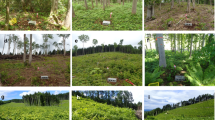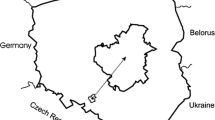Abstract
Management of post-harvest woody debris structures (e.g., piles and windrows) may help conserve mammal diversity in commercial forest landscapes. A windrow (continuous woody debris) provides a linear habitat to connect patches and reserves of uncut forest and riparian areas to maintain forest-floor small mammals and allow some of their avian and mammalian predators to access and traverse clearcut openings. However, most post-harvest residues are arranged in independent piles of woody debris (separated by 20–30 m, on average) and we asked if a linear configuration of piles would provide similar habitat conditions for small mammals as that achieved by a windrow of continuous woody debris. We tested two hypotheses (H) that piles of woody debris arranged in a linear configuration, on newly clearcut sites, would (H1) enhance (a) abundance of the major small mammal species (Myodes gapperi and Microtus spp.), and (b) total abundance, species richness, and species diversity of the forest-floor small mammal community; compared with dispersed (conventional) treatment of woody debris. H2 predicted that, because of the continuity of habitat, responses of small mammals in windrows would be greater than those in piles of woody debris. Three study areas were monitored in southern British Columbia, Canada, and each had three treatments of woody debris: dispersed, in a linear set of piles, and as a windrow. Forest-floor small mammals were sampled by live-trapping in spring and fall periods from 2010 to 2012. Woody debris in a linear configuration of piles and in windrows enhanced mean abundance of the southern red-backed vole (M. gapperi), total voles, and total abundance of small mammals compared with the dispersed treatment. Small mammal responses were variable between spring and fall periods, but overall mean values ± 95% CIs indicated that abundance of M. gapperi, total voles, and total small mammals were reasonably similar in piles and windrows.



Similar content being viewed by others
References
Andrén H (1994) Effects of habitat fragmentation on birds and mammals in landscapes with different proportions of suitable habitat: a review. Oikos 71:355–366
Bogdziewicz M, Zwolak R (2014) Responses of small mammals to clear-cutting in temperate and boreal forests of Europe: a meta-analysis and review. Eur J Forest Res 133:1–11
Bowman J, Forbes GJ, Dilworth TG (2001) The spatial component of variation in small-mammal abundance measured at three scales. Can J Zool 79:137–144
Burton PJ, Balisky AC, Coward LP, Cumming SG, Kneeshaw DD (1992) The value of managing for biodiversity. Forest Chron 68:225–237
Buskirk SW, Zielinski WJ (2003) Small and mid-sized carnivores. In: Zabel CJ, Anthony RG (eds) Mammal community dynamics. Management and Conservation in the Coniferous Forests of Western North America. Cambridge University Press, Cambridge, pp 207–249
Buskirk SW, Forrest SC, Raphael MG, Harlow HJ (1989) Winter resting ecology of marten in the central Rocky Mountains. J Wildl Manag 53:191–196
Carey AB, Kershner J, Biswell B, DeToledo LD (1999) Ecological scale and forest development: squirrels, dietary fungi, and vascular plants in managed and unmanaged forests. Wildlife Monogr No. 142. The Wildlife Society, Bethesda, MD
Christensen P, Hörnfeldt B (2006) Habitat preferences of Clethrionomys rufocanus in boreal Sweden. Landsc Ecol 21:185–194
Christensen P, Ecke F, Sandström P, Nilsson M, Hörnfeldt B (2008) Can landscape properties predict occurrence of grey-sided voles? Popul Ecol 50:169–179
Churchfield S, Rychlik L (2006) Diets and coexistence in Neomys and Sorex shrews in Bialowieźa forest, Eastern Poland. J Zool 269:381–390
Darveau M, Labbe P, Beauchesne P, Belanger L, Huot J (2001) The use of riparian forest strips by small mammals in a boreal balsam fir forest. For Ecol Manag 143:95–104
Ecke F, Löfgren O, Hörnfeldt B, Ekelund U, Ericsson P, Sörlin D (2001) Abundance and diversity of small mammals in relation to structural habitat factors. Ecol Bull 49:165–171
Ecke F, Löfgren O, Sorlin D (2002) Population dynamics of small mammals in relation to forest age and structural habitat factors in northern Sweden. J Appl Ecol 39:781–792
Ecke F, Christensen P, Rentz R, Nilsson M, Sandstrom P, Hörnfeldt B (2010) Landscape structure and the long-term decline of cyclic grey-sided voles in Fennoscandia. Landsc Ecol 25:551–560
Fauteux D, Imbeau L, Drapeau P, Mazerolle MJ (2012) Small mammal responses to coarse woody debris distribution at different spatial scales in managed and unmanaged boreal forests. For Ecol Manag 266:194–205
Fisher JT, Wilkinson L (2005) The response of mammals to forest fire and timber harvest in the North American boreal forest. Mamm Rev 35:51–81
Fowler J, Cohen L, Jarvis P (1998) Practical statistics for field biology. Second Edition. John Wiley and Sons, p 259
Gliwicz J, Glowacka B (2000) Differential responses of Clethrionomys species to forest disturbance in Europe and North America. Can J Zool 78:1340–1348
Gunther PM, Horn BS, Babb GD (1983) Small mammal populations and food selection in relation to timber harvest practices in the western Cascade Mountains. Northwest Sci 57:32–44
Hansson L (1988) Grazing impact by small rodents in a steep cyclicity gradient. Oikos 51:31–42
Hansson L (1996) Habitat selection or habitat-dependent survival: on isodar theory for spatial dynamics of small mammals. Oikos 75:539–542
Hardy CC (1996) Guidelines for estimating volume, biomass, and smoke production for piled slash. Gen. Tech. Rep. PNW-GTR-364. Portland, OR: USDA Forest Service, Pacific Northwest Research Station, 17pp
IBM Corp. (2016) IBM SPSS statistics for windows, version 23.0. IBM Corp, Armonk, NY
Jędrzejewska B, Jędrzejewski W (1998) Predation in vertebrate communities: the Bialowieźa Primeval Forest as a case study. Springer, Berlin
Keenan RJ, Kimmins J (1993) The ecological effects of clear-cutting. Environ Rev 1:121–144
Kirkland GL (1990) Patterns of initial small mammal community change after clearcutting North American forests. Oikos 5:313–320
Krebs CJ (1999) Ecological methodology. Addison Wesley Longman, Inc, p 624
Krebs CJ, Keller BL, Tamarin RH (1969) Microtus population biology: demographic changes in fluctuating populations of M. ochrogaster and M. pennsylvanicus in southern Indiana. Ecology 50:587–607
Kuehl RC (1994) Statistical principles of research design and analysis. Duxbury Press, Belmont, California
Lindenmayer D, Burton PJ, Franklin JF (2008) Salvage logging and its ecological consequences. Island Press, Washington, DC, p 227
Lisgo KA, Bunnell FL, Harestad AS (2002) Summer and fall use of logging residue piles by female short-tailed weasels. USDA For. Serv. Gen. Tech. Rep. PSW-GTR-181, pp 319-329
Littel RC (1989) Statistical analysis of experiments with repeated measures. HortSci 24:36–40
Maisonneuve C, Rioux S (2001) Importance of riparian habitats for small mammal and herpetofaunal communities in agricultural landscapes of southern Québec. Agr. Ecosyst Environ 83:165–175
Martin SK (1994) Feeding ecology of American martens and fishers. In: Buskirk SW, Harestad AS, Raphael MG, Powell RA (eds) Martens, sables, and fishers. Biology and Conservation. Comstock Publ. Assoc., Cornell University Press, Ithaca, pp 297–315
Maser C, Claridge AW, Trappe JM (2008) Trees, truffles, and beasts: How forests function. Rutgers University Press, Piscataway, NJ
McComb WC (2003) Ecology of coarse woody debris and its role as habitat for mammals. In: Zabel CJ, Anthony RG (eds) Mammal community dynamics. Management and Conservation in the Coniferous Forests of Western North America. Cambridge University Press, Cambridge, pp 374–404
Meidinger D, Pojar J (1991) Ecosystems of British Columbia. Special Report Series No. 6. Research Branch, Min. Forests, Victoria, BC, Canada
Merritt JF (1981) Clethrionomys gapperi. Mammalian species. No. 146. American Society of Mammalogists, Provo
Nagorsen DW (1996) Opossums, shrews, and moles of British Columbia. Volume 2. The mammals of British Columbia. UBC, Vancouver, BC, Canada
Nordyke KA, Buskirk SW (1991) Southern red-backed vole, Clethrionomys gapperi, populations in relation to stand succession and old-growth character in the central Rocky Mountains. Can Field-Nat 105:330–334
Pearce J, Venier L (2005) Small mammals as bioindicators of sustainable boreal forest management. For Ecol Manag 208:153–175
Pearson DE, Ruggiero LF (2001) Test of the prey-base hypothesis to explain use of red squirrel midden sites by American martens. Can J Zool 79:1372–1379
Pearson DE, Ruggiero LF (2003) Transect versus grid trapping arrangements for sampling small-mammal communities. Wildl Soc Bull 31:454–459
Rosenvald R, Lõhmus A (2008) For what, when, and where is green-tree retention better than clearcutting? A review of biodiversity aspects. For Ecol Manag 255:1–15
Schickmann S, Urban A, Krautler K, Nopp-Mayr U, Hacklander K (2012) The interrelationship of mycophagous small mammals to ectomycorrhizal fungi in primeval, disturbed, and managed Central European mountainous forests. Oecologia 170:395–409
Schloyer CR (1977) Food habits of Clethrionomys gapperi on clearcuts in west Virginia. J Mammal 58:677–678
Seber GAF (1982) The estimation of animal abundance and related parameters, 2nd edn. Charles Griffin, London
Seibold S, Bassler C, Brandl R, Gossner MM, Thorn S, Ulyshen MD, Muller J (2015) Experimental studies of dead-wood biodiversity—a review identifying global gaps in knowledge. Biol Conserv 191:139–149
Siitonen J (2001) Forest management, coarse woody debris and saproxylic organisms: Fennoscandian boreal forests as an example. Ecol Bull 49:11–41
Soininen EM, Ravolainen VT, Brathen KA, Yoccoz NG, Gielly L, Ims RA (2013) Arctic small rodents have diverse diets and flexible food selection. PLoS One 8:e68128
Sullivan TP, Sullivan DS (2012) Woody debris, voles, and trees: Influence of habitat structures (piles and windrows) on long-tailed vole populations and feeding damage. For Ecol Manag 263:189–198
Sullivan TP, Sullivan DS, Sullivan JH (2017) Mammalian responses to windrows of woody debris on clearcuts: abundance and diversity of forest-floor small mammals and presence of small mustelids. For Ecol Manag 399:143–154
Sullivan TP, Sullivan DS, Lindgren PMF, Ransome DB (2010) Green-tree retention and life after the beetle: stand structure and small mammals 30 years after salvage harvesting. Silva Fenn 44:749–774
Sullivan TP, Sullivan DS, Lindgren PMF, Ransome DB (2012) If we build habitat, will they come? Woody debris structures and conservation of forest mammals. J Mammal 93:1456–1468
Van Wagner CE (1968) The line intersect method in forest fuel sampling. For Sci 14:20–26
Zar JH 1999. Biostatistical analysis. Prentice-Hall, Inc., Englewood Cliffs, N. J. p 663
Zwolak R (2009) A meta-analysis of the effects of wildfire, clearcutting, and partial harvest on the abundance of North American small mammals. For Ecol Manag 258:539–554
Acknowledgements
We thank the Natural Sciences and Engineering Research Council of Canada, British Columbia Habitat Conservation Trust Foundation, Gorman Bros. Lumber Ltd., Aspen Planers Ltd., Jaeden Resources Ltd., Gold Mountain Mining Corp., and the Applied Mammal Research Institute for financial and logistical support. T. Ball, S. Clerke, D. Gossoo, A. LaChapelle, K. Rouck, and R. Wilson were particularly helpful in assisting with this project. We thank H. Sullivan for assistance with the fieldwork.
Author information
Authors and Affiliations
Corresponding author
Ethics declarations
All handling of animals was in accordance with the principles of the Animal Care Committee, University of British Columbia.
Additional information
Communicated by: Thales Renato Ochotorena de Freitas
Rights and permissions
About this article
Cite this article
Sullivan, T.P., Sullivan, D.S. Maintenance of small mammals using post-harvest woody debris structures on clearcuts: linear configuration of piles is comparable to windrows. Mamm Res 63, 11–19 (2018). https://doi.org/10.1007/s13364-017-0336-y
Received:
Accepted:
Published:
Issue Date:
DOI: https://doi.org/10.1007/s13364-017-0336-y




